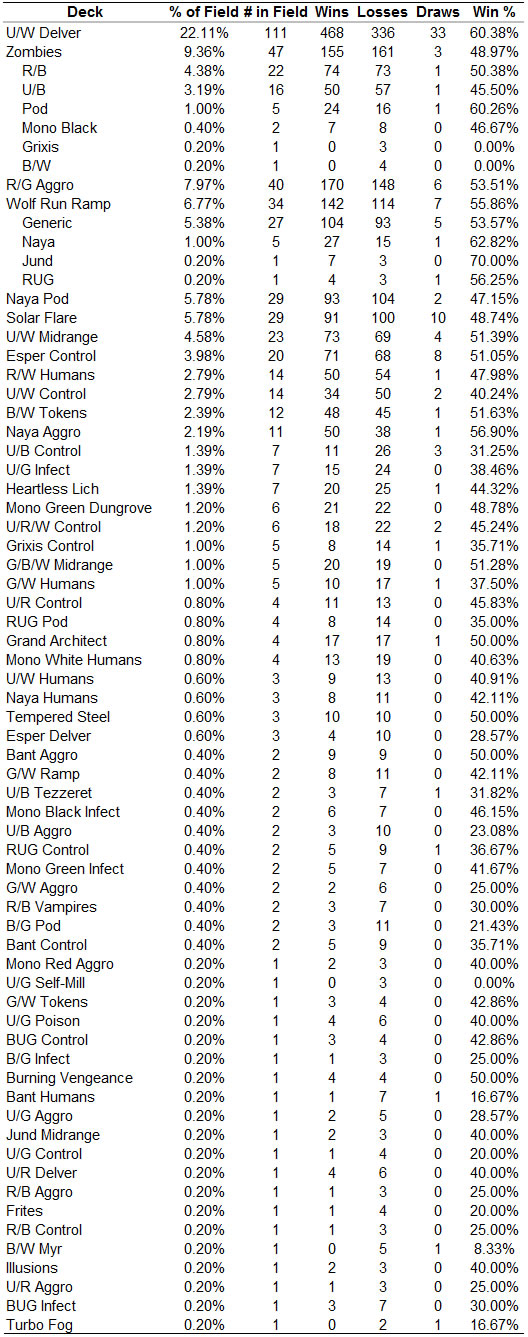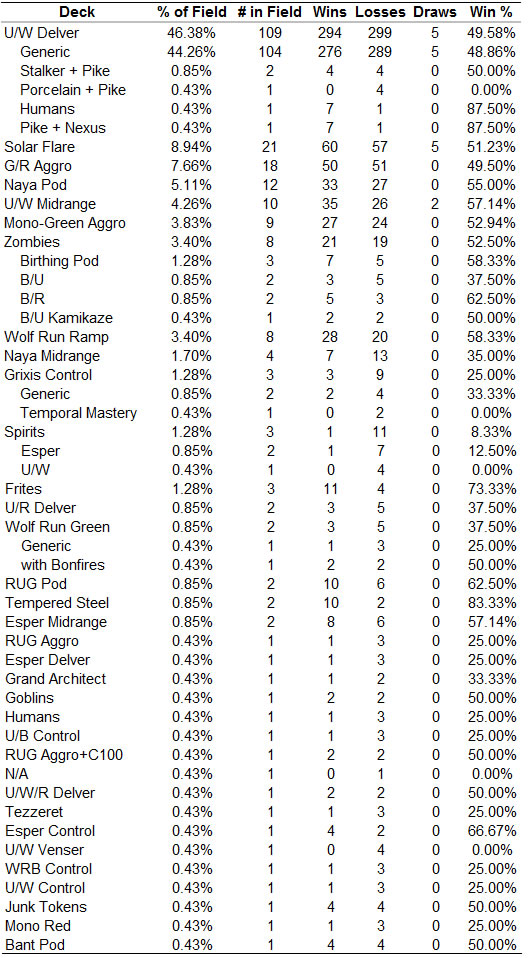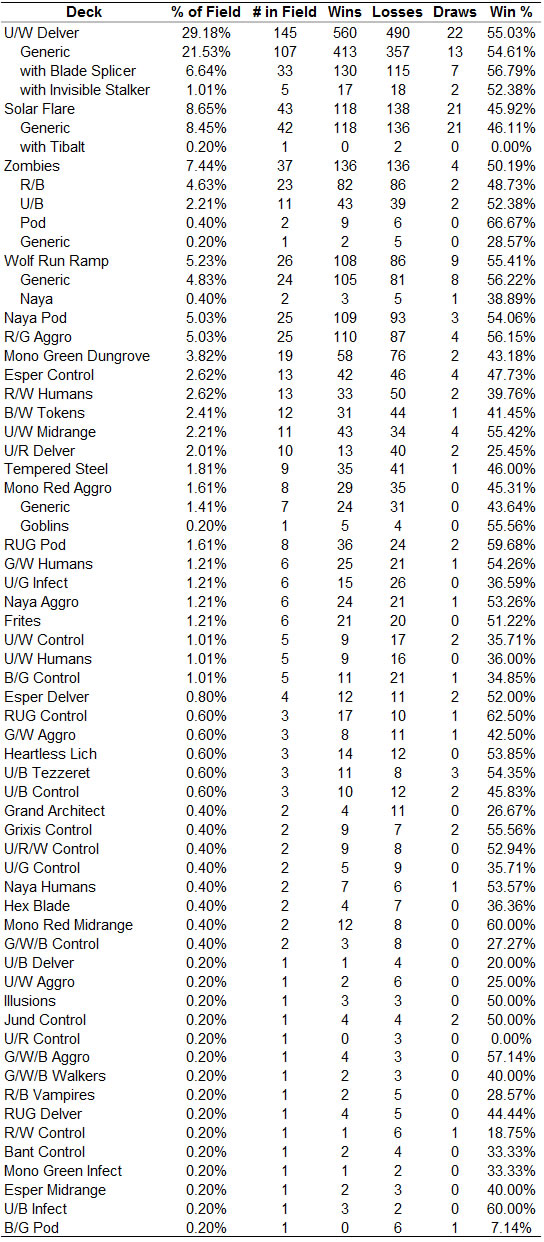Welcome to my first iteration of Too Much Information! Three big Standard events passed us by in the last few weeks. From the SCG Standard Open in Worcester to the SCG Invitational and Open that took place in Indianapolis, there’s a whole lot of information to devour.
Worcester Standard Open
Unsurprisingly, U/W Delver took up the largest amount of the field by over twice as much as the next contender. It also boasted the highest win percentage among significantly played decks by about 5% and put six of its pilots into the Top 8. Considering how good those numbers are, it’s interesting to think that they might be being brought down by the deck’s difficulty factor. It’s certainly one of the hardest decks to play in the format.
The second largest played deck, to my surprise, was Zombies. B/R edged out B/U as the most popular version, but the best performing version (with a win percentage that rivals Delver’s) was Zombie Pod. I know that Michael Jacob has been playing with Zombie Pod a bit, but other than that the deck hasn’t been getting much support. It could be a sleeper in the format.
G/R Aggro was the next most played deck. It managed to put one player in the Top 8 and kept a win percentage of 53.5%.
Wolf Run Ramp was next on the list. While regular G/R Wolf Run Ramp had the same win percentage as G/R Aggro, two of its highest placing versions were incredibly unusual. It would be interesting to see if these decks could put up a repeat performance, but I’m not sure we’ll see much of them again.
Creatures (17)
- 4 Solemn Simulacrum
- 4 Primeval Titan
- 2 Wurmcoil Engine
- 3 Thrun, the Last Troll
- 1 Elesh Norn, Grand Cenobite
- 3 Huntmaster of the Fells
Lands (26)
Spells (17)

 This version took both its losses from Delver.
Creatures (20)
- 4 Solemn Simulacrum
- 4 Birds of Paradise
- 1 Acidic Slime
- 1 Borderland Ranger
- 4 Primeval Titan
- 1 Viridian Emissary
- 1 Elesh Norn, Grand Cenobite
- 1 Phyrexian Metamorph
- 1 Huntmaster of the Fells
- 1 Sigarda, Host of Herons
- 1 Somberwald Sage
Lands (26)
Spells (14)

And this Birthing Pod version took a loss from Delver and from Zombies.
Despite winning the event, Solar Flare didn’t even scrape together a 50% win rate (but when coupled with “Esper Control,” it’s pretty close). Interestingly, we saw some RUG Pod show up here, though it only managed a 35% win rate.
Indianapolis Invitational
While everyone knew U/W Delver would be the biggest deck at the Invitational, I’m not sure anyone could have predicted this amount. Almost half the players played Delver! That amounts to six times the next most played deck! Clearly Delver is a favorite among higher-level players. Besides that, the other half of the format was pretty diverse. Thirty-three archetypes made up the remainder of the event.
So what does Delver have to show for such a high percentage of the field?
A win rate of 49.58%…
That’s over 10% lower than in Worcester. Once again, I don’t think anyone could have predicted this outcome.
We can (safely) assume that the caliber of player at an Invitational is, on average, higher than that of an Open player. You’d think that would lead to an increase in Delver’s win percentage from one event to the next, not a 10% decrease.
Without researching the data, the first explanation I came up with was that Delver just gets worse at an event where players know exactly what to expect. This could mean that players came prepared to crush Delver with a favorable matchup and/or that they just knew how to play against it very well. But it’s pretty difficult to quantify that theory in terms of data.
According to the data, there were eleven decks (which made up 29% of the field) with win rates of over 50% against Delver, as follows:
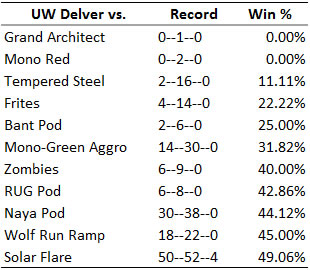
This leaves us with four decks that played against Delver a significant amount. In order of performance in the matchup, those decks are: Mono-Green Aggro, Naya Pod, Wolf Run Ramp, and Solar Flare.
Creatures (24)
- 4 Llanowar Elves
- 4 Birds of Paradise
- 1 Acidic Slime
- 2 Borderland Ranger
- 1 Bellowing Tanglewurm
- 2 Phyrexian Metamorph
- 4 Dungrove Elder
- 4 Strangleroot Geist
- 1 Wolfir Silverheart
- 1 Ulvenwald Tracker
Planeswalkers (3)
Lands (23)
- 23 Forest
Spells (10)

I don’t know what it is about MGA that suddenly made it start beating Delver, but its win percentage in the matchup went up from Worcester by 60%. That’s a pretty serious number. With a respectable overall win percentage of 52.94%, maybe this deck is a sleeper of the format.
Creatures (31)
- 4 Birds of Paradise
- 2 Borderland Ranger
- 1 Phyrexian Metamorph
- 4 Blade Splicer
- 1 Fiend Hunter
- 4 Avacyn's Pilgrim
- 3 Strangleroot Geist
- 2 Thalia, Guardian of Thraben
- 3 Huntmaster of the Fells
- 4 Restoration Angel
- 1 Zealous Conscripts
- 2 Wolfir Silverheart
Planeswalkers (1)
Lands (24)
Spells (4)

Naya Pod didn’t actually do well enough to place in the Invitational, so that’s certainly a strike against it. But in addition to its good showing against Delver, it had a 55% percent overall win rate.
Creatures (16)
Lands (26)
Spells (18)

The percentage of Wolf Run Ramp players dropped by half from Worcester to the Invitational. Its win percentage against Delver stayed almost exactly the same between the two events.
Creatures (6)
Planeswalkers (2)
Lands (26)
Spells (26)

After its win in Worcester, Solar Flare showed up in larger numbers at the Invitational, enough to make it the second most played deck. With so many different versions floating around, it’s hard to say whether or not it really has a good Delver matchup, but in the Invitational it managed to barely stay above 50% in the matchup and against the field.
Besides these four, there were another two decks that did a number on Delver, though they showed up in much fewer numbers.
Creatures (17)
Lands (24)
Spells (19)

Creatures (22)
Lands (21)
Spells (17)

Despite having really good win percentages against both the field and Delver, these two decks have a flaw that prevents them from becoming big. Their flaw is being weak to hate cards. When either of these decks becomes a target they lose their edge in the format very quickly, which is why I think they were good choices for this event but poor ones for future events. If people expect them in reasonable numbers they’ll start packing Surgical Extraction and Ancient Grudge.
The decks that ended with less than 50% wins against Delver are as follows:
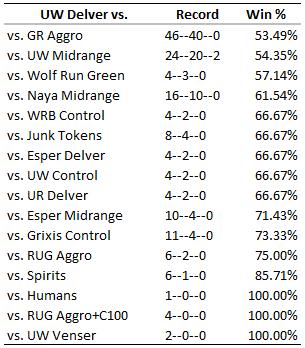
In the future, I don’t think Delver will come close to the percentage played in the Invitational so choosing to play some of these decks isn’t entirely out of the question, but keep in mind that you’ll likely have to play against Delver at least three times to win a PTQ.
Indianapolis Standard Open
The field for the Indianapolis Open largely resembles that of the Invitational. Delver still took up a very high percentage of the field, though its win percentage went back up to 55%.
Solar Flare was still the second most played deck, but it’s win percentage actually dropped by 5%. Zombies jumped to third most played, which more resembles Worcester’s numbers. It did slightly worse than in the Invitational but still had a win percentage over 50%. Wolf Run Ramp also increased in numbers and did worse than at the Invitational, but it still had a higher win percentage than Delver in this event. Naya Pod pretty much stayed the same both in percentage played and win percentage. G/R Aggro saw a drop in numbers but also a 6.65% increase in win percentage.
The Top 8 of the Indy Open is certainly the most interesting thing about it. It featured only one Delver player, something we haven’t seen in a while, but that one Delver player still managed to win the event. The Top 8 also featured two of the eight players that played RUG Pod and one of three that played a Tezzeret deck.
Creatures (27)
- 4 Llanowar Elves
- 4 Birds of Paradise
- 1 Acidic Slime
- 1 Borderland Ranger
- 1 Aether Adept
- 1 Inferno Titan
- 1 Phyrexian Metamorph
- 1 Deceiver Exarch
- 2 Phantasmal Image
- 1 Daybreak Ranger
- 4 Strangleroot Geist
- 4 Huntmaster of the Fells
- 1 Zealous Conscripts
- 1 Wolfir Silverheart
Lands (24)
Spells (9)

Creatures (6)
Planeswalkers (4)
Lands (25)
Spells (25)

Now let’s take a look at the data for the top played decks for all three events:
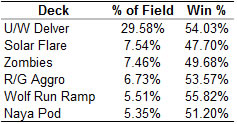
U/W Delver Matchups
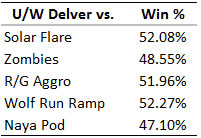
By these numbers, Delver doesn’t exactly deserve to be such a big piece of the format. Of the remaining top six played decks, it barely boasts better than 50% against three of them and has just under 50% against the other two. If people are still gunning for Delver (which they should be because it’s still the most played deck), it’s possible that we could see it fall.
Solar Flare Matchups
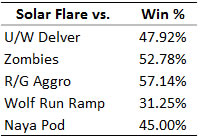
Solar Flare has some fair numbers but takes a serious dive in the Wolf Run Ramp matchup. I’d guess that Cavern of Souls is to blame for that. Mana Leak coupled with Dissipate out of the board used to be their best way to combat Titans, but now they can’t afford that luxury. They still have tools to work with in the matchup but apparently not enough.
Zombies Matchups
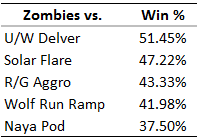
Zombies was the third most played deck, but it’s matchups against the top decks are horrendous. It only has one matchup above 50%, and it’s not by much. The thing about Zombies is that there are so many different versions that it’s hard to tell which one is the best and which ones are bringing down the numbers. I know that if I were going to play Zombies I would do some digging on the Birthing Pod version. That card seems to enable so many strategies to become good ones.
G/R Aggro Matchups
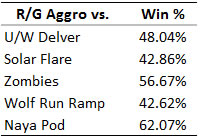
G/R has always had a poor matchup in Wolf Run Ramp, and that hasn’t changed since they’ve adopted Zealous Conscripts in the sideboard. It also sports weak matchups against the top two decks.
Wolf Run Ramp Matchups
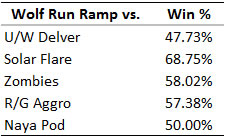
Here’s a surprise. Wolf Run Ramp is boasting good matchups against three of the top decks, splitting one and only showing a little weakness to the top dog. Why aren’t people playing more of this deck then? Well, I think people are scared to play it because of its weakness to Delver. After all, that deck is going to be twice as played as the next deck on the list. If someone is able to fix that matchup, we might have a serious contender for upcoming events.
Naya Pod Matchups
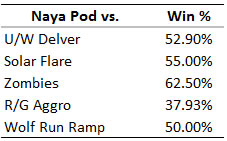
Another surprise! Naya Pod is doing much the same that Wolf Run Ramp is doing but winning more often against Delver and sacrificing points against a lesser played deck. This is another deck that seems like it should be seeing more play than it is.
One thing that has become clear from all this data is that Delver is overplayed! The deck doesn’t seem be the menace that it’s been made out to be. There are other decks that are not only putting up numbers against Delver, but against the rest of the field as well.
Yes, you still want to be able to beat Delver, but keep in mind that you’ll have to beat a myriad of other decks too. Delver made up 30% of a large field, but that still left 70% other decks. There are tons of other decks to beat (and play!).
Thanks for reading!
Find me on Twitter @theshipitholla
Watch my Livestream http://www.twitch.tv/theshipitholla

